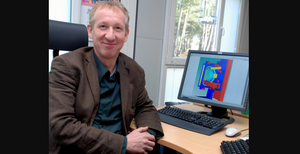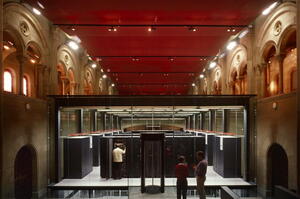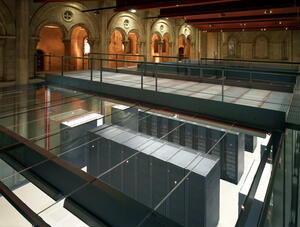The ITER machine, from a neutron's point of view
Michael Loughlin's job at ITER's Project Office is to write "histories" and, like any writer today, he does it on a computer. But the "histories" he writes are unique: they are about the collective behaviour of billions and billions of individual particles called neutrons and how they move about and interact with the material of the ITER machine. As a result, the computer he uses is unique too.
"Particle movements," explains Michael, "involve quantum mechanics. At the individual level, the movement is random. But when you have an enormous population of particles, their average becomes predictable." Sixty years ago, when scientists began modelling particle behaviour, they would repeatedly throw dice and extrapolate the results with a slide ruler. This approach, dubbed the "Monte Carlo method," proved efficient and is still widely used today. The method is the same, but the dice and slide rulers have been replaced by fast and powerful supercomputers.
The one Michael and his team at Nuclear/Shielding Analysis use is a 10,000-processor monster machine called Mare Nostrum, the Roman name for the Mediterranean Sea. It is housed at the Polytechnic University of Catalonia, in Barcelona, Spain.
"The architecture of the machine is well adapted to our needs. But we don't need its full computing power, and we don't need it all the time." Like others in human genome research, astrophysics or weather forecasting, ITER has bought "CPU time" (one million hours) on Mare Nostrum. Theoretically, ITER could use just one of the computer's 10,000 chips for a million hours, or, more realistically, 100 chips for 10,000 hours, 1,000 chips for 1,000 hours, etc.
In computer parlance, the Monte Carlo technique is termed "embarrassingly parallel." This means that it can deal with a problem by breaking it into a number of parallel tasks: the more processors the computer effectively uses, the faster the problem will be solved.
"Understanding the way particles travel and transport radiation is essential to assuring that ITER will function correctly and safely," says Michael. "It is also essential, at this stage of the project, to be able to model the whole thing every time a small change is made in any one system. In a way that we haven't been able to do before, Mare Nostrum provides us with an overall view of the ITER machine from a neutron's point of view and helps us make unforeseen effects become apparent."
In January 2008, Michael Loughlin went to install software on Mare Nostrum, whose steel-and-glass enclosure occupies the entire nave of an early 20th century chapel, deconsecrated and beautifully redesigned. There, under the arches of the nave, amid the low-frequency hum of the cooling system, he admits he "couldn't help but feel reverential."




